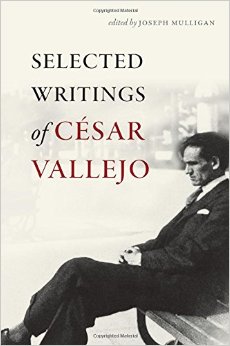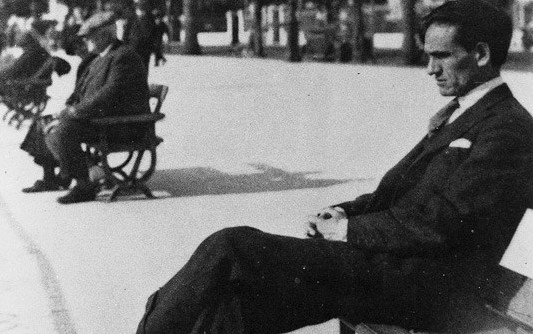The Work of Art and the Social Sphere
César Vallejo
Is there even a narrow correlation between the life and work of the artist? Is there absolute synchronism between the work and life of the author? Yes. Synchronism exists in artists great and small, in conservatives and revolutionaries alike. Synchronism has been produced in the past, is currently produced, and will be produced forever. Even in the case of artists whose work seems to lack the peculiar tone of their life at first sight, the profound and sometimes underlying concordance is evident. To reach that tone, suffice an auscultation in good faith, with a bit of sensibility.
Let’s look at a few examples. Nietzsche was a physically weak, sickly man. Is one to deduce from this that The Birth of Tragedy is the wincing of a wasted loser? Tolstoy never had financial burdens. He didn’t know what it means to put bread on the table by working. He lived the life of a petite bourgeois man or, rather, a feudal lord. Is one to deduce from this that Resurrection is a feudalizing work? Mallarmé lived in perpetual political abstention, neural to the ebb and flow of parliaments, absent at elections, assemblies, and political party gatherings. Is one to deduce from this that The Afternoon of the Faun is devoid of political spirit and social meaning? Of course not. Such conclusions are reached only by run-of-the- mill, empirical critics. Akin to a poor photographer who seeks in photography the formal reproduction and external imitation of the original, the poor critic scours the work of art to find the literal reproduction and reflection of repetition in the artist’s life. When he does not find that reflection—which, let us add, occurs precisely with the great artists—he concludes by saying that there is no synchronism in the life of the author and his work. This is how people proceed who believe that concordance exists in some but not all artistic objects.
To find truly profound aesthetic synchronism, one must bear in mind that the phenomenon of artistic production, as Millet says, is an authentic operation of alchemy, in the scientific sense of the word—a transmutation. The artist absorbs and concatenates the social unrest of the environment as well as his own individual unrest, not to return it exactly as he absorbed it (which is what the poor critic would want and what occurs with inferior artists), but rather to transform it within his spirit into other essences, distinct in form and identical at the core, into the raw materials as absorbed. At first sight, as we said, one might not recognize the vital raw material as absorbed in the structure and emotional movement of the work, just as at a glance one might not recognize in a tree the nutritional chemical bodies extracted from the soil. However, if one analyzes the work in depth, one will necessarily discover—in its innermost viscera and through the personal peripeteia of the artist’s life—not only the circulating currents of socioeconomic character, but the mental and religious currents of its epoch. An alchemical analysis of a vegetal substance would likewise establish a similar biological phenomenon in the tree.
The correlation between the individual and social life of the artist and his work is therefore constant. It operates consciously or subconsciously, whether the artist wants it to or not, no matter if he accepts or denies it, and even if he tries to escape it. The challenge for the critic—we repeat—is knowing how to discover it.

Aesthetic and Machinism
The heavenliness of the moonlight in poetry has been superseded by the heavenliness of the cinema, the airplane, the radio, or whichever other quasi-“ futurist” smack you please. Bourgeois professors, philosophers, and artists have a concept sui generis of the role of the machine in social and artistic life and attribute a sort of divine character to it. The idealism and inclination toward mysticism, located in the foundation of these people’s criterion, made them see the machine, at the onset of Fulton’s invention, as an idol or new divinity as mysterious as all divinities, before which one had to kneel in simultaneous adoration and fear. And even now they take up this attitude. Bourgeois artists and writers, particularly, have used the machine to symbolize Beauty with a capital B, while philosophers use it to symbolize Omnipotence with a capital O. Among the former is the fascist, Marinetti, inventor of futurism, and among the latter, the patriarch, Tagore, whose shouts and cries for help against the Jupiterian empire of the machine haven’t managed to jostle the accursed Fordic mindset of capitalist “culture.”
But the revolutionary artist has a different concept of and feeling toward the machine. For him, a motor and a plane aren’t more than objects, like a table or a toothbrush, with one difference: the former are more beautiful and useful, in sum, they possess greater creative efficiency. Only that. Following this hierarchical evaluation of objects in social reality, the revolutionary artist can do more when placing them in the work of art. The machine isn’t an aesthetic, moral, or even economic myth. Just as no worker with class consciousness sees a deity in the machine or falls to his knees before it like a resentful slave, so too does the revolutionary artist refrain from using it to symbolize Beauty par excellence, the new aesthetic prototype of the universe, or the unseen and revealed muse of artistic inspiration. Nor has the Marxist sociologist assigned the tractor a totemic value in the proletarian family and socialist society.
In the wake of the October Revolution, the futurist wave that rolled through Russian art and, specifically, through poetry was quite explainable and fortunately has been ephemeral. It was an undercover, old-fashioned surge of the recently crushed capitalist era. Mayakovsky, its major representative at the time, ended up recognizing it as such very quickly and, together with Pasternak, Esenin, and others, boycotted all machinist residuals in literature.
When Gladkov exclaims, “the nostalgia for machines is stronger than the nostalgia for love,” he says it only as one could say, “the nostalgia for machines is stronger than the nostalgia for my room” or anything else. It’s not that the machine is elevated, but that love is terrifying. And in this case the sentiment that Walt Whitman possesses is excluded, for he, unaware of its social and aesthetic value, set it in motion and applied it with impressive justness.
So mistakenly wander today’s poets who make the machine a goddess, like those who before them made a goddess out of the moon, sun, or sea. Neither deification nor heavenliness of machines. This is but an instrument of economic production and, as such, only an element of artistic creation, like any other, similar to a window, a cloud, a mirror, or a path, etc. Everything else amounts only to a newly coined animism that is arbitrary, morbid, decadent.
* Excerpt from The Selected Writings of César Vallejo, translated and edited by Joseph Mulligan. Courtesy of Wesleyan University Press. All rights reserved.
Posted: September 10, 2015 at 9:01 pm










